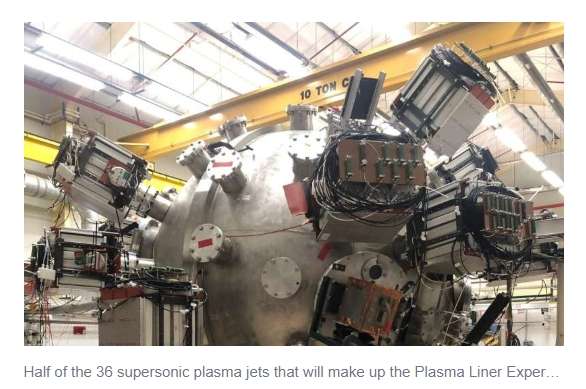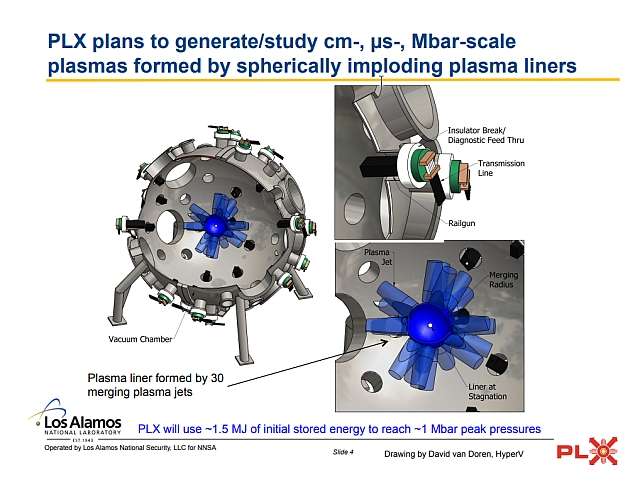"Assembly of the Plasma Liner Experiment (PLX) at Los Alamos National Laboratory is well underway with the installation of 18 of 36 plasma guns in an ambitious approach to achieving controlled nuclear fusion (Figure 1). The plasma guns are mounted on a spherical chamber, and fire supersonic jets of ionized gas inward to compress and heat a central gas target that serves as fusion fuel. In the meantime, experiments performed with the currently installed plasma guns are providing fundamental data to create simulations of colliding plasma jets, which are crucial for understanding and developing other controlled fusion schemes.
Most fusion experiments employ either magnetic confinement, which relies on powerful magnetic fields to contain a fusion plasma, or inertial confinement, which uses heat and compression to create the conditions for fusion.
The PLX machine combines aspects of both magnetic confinement fusion schemes (e.g. tokamaks) and inertial confinement machines like the National Ignition Facility (NIF). The hybrid approach, although less technologically mature than pure magnetic or inertial confinement concepts, may offer a cheaper and less complex fusion reactor development path. Like tokamaks, the fuel plasma is magnetized to help mitigate losses of particles and thermal energy. Like inertial confinement machines, a heavy imploding shell (the plasma liner) rapidly compresses and heats the fuel to achieve fusion conditions. Instead of NIF's array of high-power lasers driving a solid capsule, PLX relies on supersonic plasma jets fired from plasma guns.
The PLX has an additional advantage: Because the fusion fuel and liner are initially injected as a gas, and the plasma guns are located relatively far from the imploding fuel, the machine can be fired rapidly without damage to the machine components or the need for replacement of costly machined targets.
"We will conduct experiments this year to study the formation of a hemispherical liner with 18 guns installed," said Dr. Samuel Langendorf, a scientist with the lab's Experimental Physics Group who is leading the assembly of PLX. "We hope to complete the installation of the remaining 18 guns in early 2020 and to be conducting fully spherical experiments by the end of 2020. This will allow us to measure the scaling of the liner ram pressure on stagnation as well as the liner uniformity, which are important metrics of the liner performance."
In its partially completed state, the PLX guns are proving useful in studies that Dr. Tom Byvank is performing on colliding plasmas (Figure 2).
"Different models show discrepancies in the simulations of plasma collisions involving multiple ion species," said Dr. Byvank, a postdoc in the Experimental Physics Group. "Our experimental observations of these plasmas help to validate simulations that are important for understanding high-energy-density, supersonic plasmas encountered in astrophysics, aerodynamics and various plasma fusion machines, including the PLX magneto-inertial fusion approach and possibly also inertial confinement designs like the National Ignition Facility."
Key exerpt, for me at least, is that there is apparently a second method to achieve fusion conditions apart from magnetic confinement, namely inertial confinement. Thanks to the work at the Los Alamos National Laboratory it is now possible to envisage a third way: the combination of the two technologies.

It strikes me as weird that they are going to conduct "experiments" with only half of the plasma guns installed. I suppose these 18 will be organized in a configuration that covers a sphere in the most evenly-spread way this small number allows, but still... as a complete layman, I wonder. I would tend to think that you do experiments of this kind only with the maximum constellation that was originally planned.
MFBB.
